Photos and the Archives
The late Michael Ryder gathered together an archive of information and photographs of the countryside, village life and the people of Holme-next-the-Sea.
New photos, postcards and other items are still being added to the archive.
The casual visitor will find much of interest here and you may well linger for some time amongst these pages!
To enter a world of memories just click the green button...
If you have any interesting photos of the village or village events and would like to share them please contact the Webmaster at webmaster@holme-next-the-sea.co.uk
This Gallery page shows a selection of the most recent photos and other items connected with village life. Just click on the thumbnails to see a larger photo. To see any Gallery items posted here before 2015 just click the red button above...
Aurora Borealis comes to Holme-next-the-Sea!
During May 2024 the Sun was expected to reach the most active period in its 11-year solar cycle, making solar storms - and therefore the chance to see the Northern Lights (Aurora Borealis) - more likely.
Known as the solar maximum, this is when the Sun has more sunspots than usual because its magnetic field is becoming stronger and at its most complex, leading to the release of massive amounts of energy in the
form of solar flares and, crucially for aurora, Coronal Mass Ejections (CMEs).
Pat Smith, a resident of Holme-next-the-Sea, was in the right place at the right time and captured these four photos of the Aurora Borealis as seen from Holme-next-the-Sea and we thank her for giving permission to reproduce
the pictures here. Click on each thumbnail for a larger image.
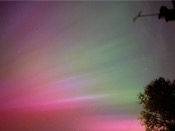
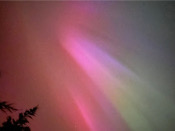
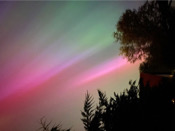

The Hun: Wetland creation and river restoration
In September 2023 the Norfolk Rivers Trust announced wetland creation and focused river improvement had been completed along a section of the river Hun to improve habitat and water quality.
The Hun is a chalk stream of just 6km, flowing from its source in Hunstanton Park to its mouth in Holme Dune National Nature Reserve (NNR). Work involved the excavation of 3 shallow scrapes, a ditch backwater,
and the creation of a new wetland – by diverting a ditch to allow a naturally low-lying area of land to seasonally fill with water. Field drains that originally flowed into the Hun and ditch were blocked to further wet the
area, while improving the quality of water reaching the river.
In addition, logs and woody material were placed in the main river channel to constrict flow, thus creating habitat for fish and invertebrates.
Dr Jonah Tosney, Technical Director at Norfolk Rivers Trust, says:
“The positive impact that the new wetland habitat is having on bird and wildlife is already exceeding our expectations.”
After the first 6-weeks since work was completed, the following birds had already been spotted visiting the wetland areas: swallows, oystercatchers, snipe, marsh harrier, spoonbill, egret, shoveller, avocet, shellduck, gadwall, stonechat,
house martin, wheatear, lapwing, redshank and sparrowhawk.

Holme-next-the-Sea Parish Councillor Martin Crown (on the left) joined a guided walk to see the newly made wetland.
For more information on this and similar projects check out the Norfolk RiversTrust website.
Strange looking object on the beach!
From time to time, and largely dependent on the winds and tides, this large object is revealed on the beach immediately adjacent to the pedestrian access to the sand from the main coastal footpath at the junction with the entrance footpath to The Firs NWT Visitor Centre.
At first glance it appears to be some kind of circular drain with an oversized 'manhole' cover. In February 2021 it appeared once again - and it is interesting to hear the various suggestions from visitors and locals alike as to the
purpose of this intriguing object. Perhaps it marks the entrance to some kind of underground tunnel leading out under the sea or was a test bore whilst searching for oil - or even a grounded flying saucer!

It was actually part of a trial Beach Dewatering Scheme built in February, 1997! The idea was to try to stabilise the beach levels without introducing permanent hard structures - apart from the one you see.
The scheme only operated for about 17 weeks and was then abandoned.
At the time of construction, back in 1997, village resident Geoff Needham took the two photos below. You can see that the drainage shaft showed far more then.

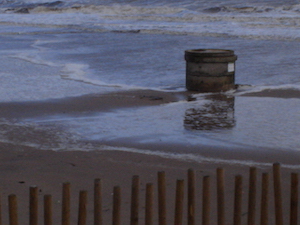
For those who wish to know more please click your way through these four short informative papers (quite technical in places...)
Coastal Morphology Report Holme-next-the-Sea
Numerical Modeling Of Groundwater Flow Behaviour In Response to Beach Dewatering
Alternative Shore Protection Strategies
Beach lowering in front of coastal structures
Scarce avian visitor to the village
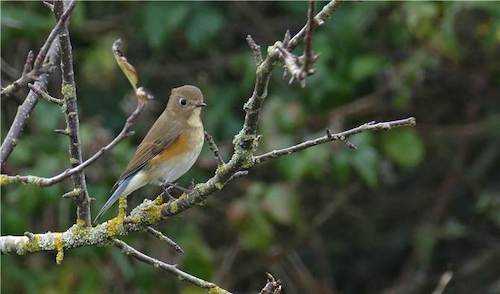
This smart little bird attracted birders from afar to Holme-next-the-Sea during the middle of October 2020. Although elusive at times, the Red-flanked Bluetail (very aptly named) was seen by many and provided an excellent 'tick' for the lucky. Surprisingly, a second of the species was also around at the same time in the vicinity of the Norfolk Wildlife Trust and Norfolk Ornithologists' Association reserves. These birds breed in Finland and N. Asia and usually winter in S.E. Asia.
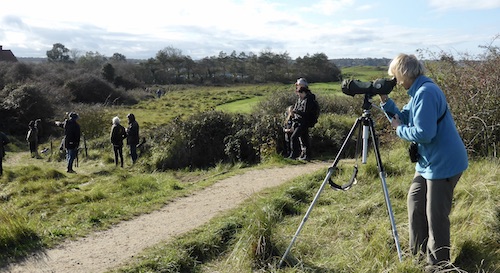
Just a few of the watchers!
Holme-next-the-Sea beach during the coronavirus lock-down
This photo was taken of the beach at Holme-next-the-Sea just 100m or so from the golf course crossing at the end of Beach Road. What makes this scene particularly poignant
is that it was taken at mid-day on Easter Sunday the 12th April 2020 on a warm and sunny day!
The village offers heartfelt thanks to all the folk who did not visit us over the Bank Holiday. Thank you for following the government's rules and staying at home.
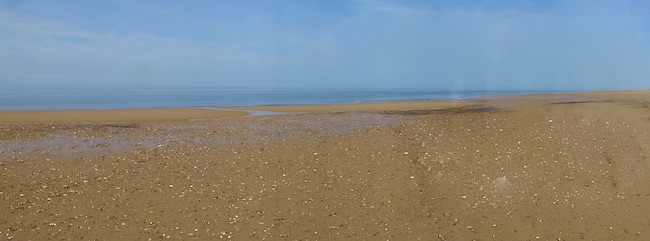
Otter seen from a NWT hide on the Holme marsh
At the end of September 2019 a holidaying couple, birders and wildlife enthusiasts, spotted this otter running across the back of the lake from a hide on the Holme Marsh Nature Reserve, which is jointly managed by the Norfolk Wildlife Trust and Courtyard Farm.
The photo is a frame from a video taken by Mr. Noel Read
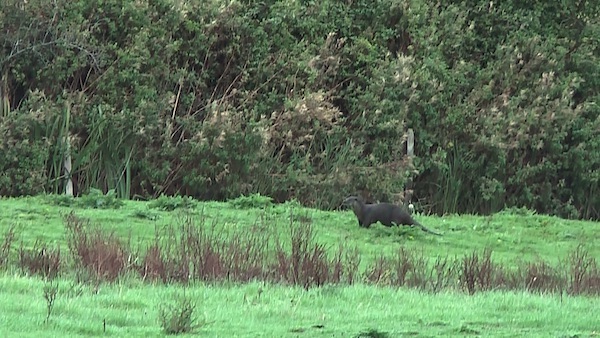
Robin's pincushion
Villagers Sally and Martin Crown were out walking locally in August 2019 and spotted this strange lookiing structure. It is known as a Robin's pincusion or rose bedeguar gall.

A type of wasp causes this 'gall' to be formed - for full chapter and verse do click on the link above.
Soft sands - sudden stop!
On the 22nd March 2018 a police car ventured onto the sands at Holme-next-the-Sea beach - possibly to investigate reports of an unexploded device found there. The
vehicle soon became stuck in the soft sands. A second police car arrived full of good intentions to rescue the first but, sadly, this second vehicle also became bogged down to join its
mate at axle depth. Eventually a vehicle more suited to playing on the sand was called into action, the cars were recovered and the beach returned to the more usual state of
peace and quiet...
Fortunately, a local dog walker, Carol Comer, was present to record the saga - many thanks for the pics.





An Old World woodpecker in the village
On 7th May, 2017 a couple of residents living in Westgate were enjoying Sunday lunch in their dining room when a small sparrow-sized, but 'different', bird showing very cryptic (camouflage) plumage landed on the lawn outside the window. It was then seen busily feeding in the garden for the next two hours.
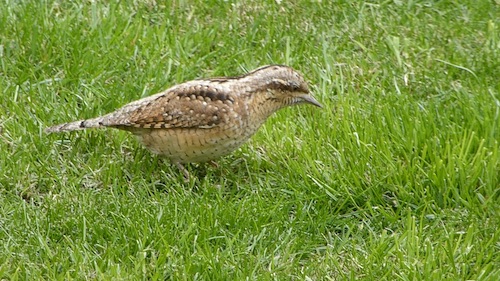
The residents, being birders for many years, recognised it as an Eurasian Wryneck (Jynx torquilla).
This strange looking little bird is a member of the Old World woodpecker family. Just like the true woodpeckers the Wryneck has a relatively large head and also a long tongue which
they use to pull out their insect prey - often ants. You can see in the photo below that the bird has two toes pointing forward and two backwards - a feature shared with the other
woodpeckers and known as zygodactyl feet.

The bird gets its English name from its ability to turn the head almost 180 degrees.
They are uncommon migrant visitors to this country being seen more in the Autumn and less likely in Spring when the few seen mostly turn up in May. This bird may well have flown to Norfolk from Africa just south of the Sahara desert!
Bugs in the churchyard!
In November, 2016 two gentlemen were seen in St. Mary's churchyard peering into a couple of what looked like washing up bowls. Enquiries revealed that they were very
interested in wildlife, particularly bugs. They belonged to a local Monday Club and occasionally visited some of the churches in the
Saxon Shore Benefice checking out the various species of buglife. The two entomologists said that some species seemed to
be especially attracted to old stone. They were very enthusiastic about the loose chunks of stoneware to be found just to the east of the main entrance to the church.
Among other bugs they found the two fairly uncommon species shown below.

The Painted Woodlouse (size about 9-12mm)
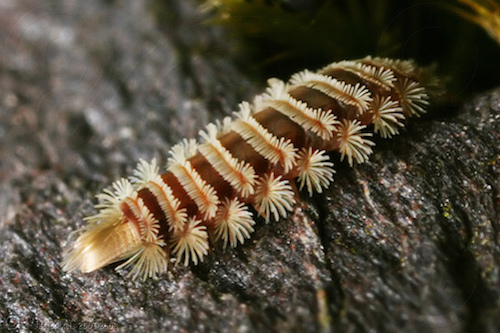
The Bristly Millipede (size about 2-3mm)
They also said that they were really pleased when they found a churchyard that wasn't totally manicured - so much better for the wildlife!
A milestone in the history of the parish!
The Milestone Society was established in May 2001 and the Society's stated aim is to “identify, record, research, conserve and interpret for public benefit the milestones
and other waymarkers of the British Isles”.
A milestone in Holme-next-the-Sea that had been missing for many years was found in February, 2016 by Miranda and Martin Skillings of Brancaster who are both members
of the Milestone Society.
The milestone was subsequently repaired with the help of the Society. In July, 2016 children from Holme-next-the-Sea were invited to help with the final painting of
the restored milestone. As a result of all this work and dedication, milestone 19 is now once again standing proudly in its place just opposite Drove Orchards on the
A149.
Click on the photos to enlarge.





Orchids in the parish!
Villagers Sally and Martin Crown were out walking in the parish, fortunately with a camera, when they spotted two species of orchid.

The Pyramidal orchid (Anacamptis pyramidalis) has a very attractive flower, unsurprisingly in the shape of a pyramid although it does become more cylindrical with
age.
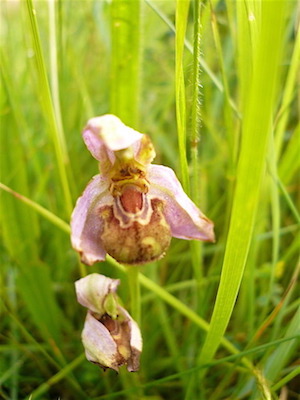
The Bee orchid (Ophrys apifera) is so called because it looks like a bee feeding at a pink flower. To complete the deception the flower emits a female bee scent and also the
fake "bee" is slightly hairy to the touch.
Air ambulance lands in the village
The East Anglian Air Ambulance service landed their helicopter G-RESU in the village on Thursday 28th April, 2016. The aircraft was expertly manoeuvred onto the grass verge at the south-west corner of the junction of Peddars Way with the A149. The on board doctor attended an incident along Main Road.

Flooding in Peddars Way North (Middle Lane)
Late in the evening of Tuesday 8th March, 2016 it started to rain in the village and the downpour continued overnight. By 10.15 a.m. the next day the most northerly
part of Peddars Way (or Middle Lane as was) was under a few inches of water. Villager and Parish Councillor Geoff Needham took these photos and said,
"This is the worst flooding in this part of the village that I have seen." Many thanks, Geoff for the pictures.



Hedgehogs
This hedgehog was seen on November 12th, 2015 in a garden on Westgate. He was busy snuffling around and hopefully stocking up for his long winter sleep.

Here is some advice from Tiggywinkles, a leading wildlife hospital, about caring for any hedgehogs you may meet in your garden:
Do leave some areas of wilderness where the hedgehogs can snuffle for insects.
Do put out water for drinking.
Do put out a bowl of dog food or meaty cat food around dusk.
Do install, in a quiet part of the garden, a hedgehog house.
Do look to see if your hedgehog is limping or appears to be injured, or in late Autumn look out for underweight hedgehogs
Don’t put out bread and milk
Don’t pick up fit hedgehogs
Don’t leave black sacks lying around.
Don’t use slug pellets or other chemicals, they may poison hedgehogs and other animals.
Don’t light a bonfire without checking to see if a hedgehog or other wild animal has moved in.
Don’t fork over compost heaps in case hedgehogs or other animals have taken up residence.
Don’t spray hedgehogs with dog or cat flea sprays. It will be detrimental to the hedgehog.
The "Supermoon" lunar eclipse 2015
In the early hours of Monday 28th September, 2015 the Earth, Sun and Moon were almost exactly in line and the Moon was on the opposite side of the Earth from the Sun.
Also, the Moon was very near its minimum distance from our planet and it looked about 7 to 8 percent larger in the sky. During this total lunar eclipse, when the full Moon moved
into our planet's shadow, it remained visible but very much dimmer. As the remaining light travelled through Earth's gaseous outer envelope, the green to violet part of the light
is filtered out more than the red portion so that the light reaching the lunar surface is mostly red in colour.
This dramatic phenomenon was last seen in 1982 and will not come around again until 2033! These photos were taken over Holme-next-the-Sea - click on the thumbnails
for a larger image.




Hummingbird Hawk Moth
On the 3rd September, 2015 this amazing Hummingbird Hawk Moth was seen in a village garden. Often seen on red Valerian this one is feeding on the flowers in a planter. You can see the long proboscis the moth uses to drink the flower's nectar.



The Church Fête 2015
On 8th August, 2015 the annual Church Fête was held in the grounds of Whitehall Farm by kind permission of the owner, Mr. David Gorton. This most traditional of fêtes featured lots of fun and games for children and adults alike and the Hunstanton Concert Band provided music during the afternoon. A glorious summer's day and lots of visitors made this a splendid event. These photos were taken by Susan Bowden-Pickstock.













Service in St. Mary's for Pets and Owners!
On Sunday 14th June, 2015 a special service was held in St. Mary's for pets - with their owners of course! Rev. Susan Bowden-Pickstock managed everything in excellent style despite the occasional barking and woofing from the congregation - and a certain amount of howling during the hymns, most of which came from the pets. Here are some photos taken throughout the service. Some of the focussing is poor but the event was dynamic with both owners and pets constantly on the move!































Great Tits nesting
A family of Great Tits have taken residence in an earthenware pot laying on its side in a Holme-next-the-Sea garden. The male has a broad breast stripe whilst the female has a narrower stripe. The pair have been very busy feeding the chicks and the diet seems to be mainly caterpillars. Sadly, one chick has not survived but hopefully the rest of the brood will fledge successfully.






Red Kite
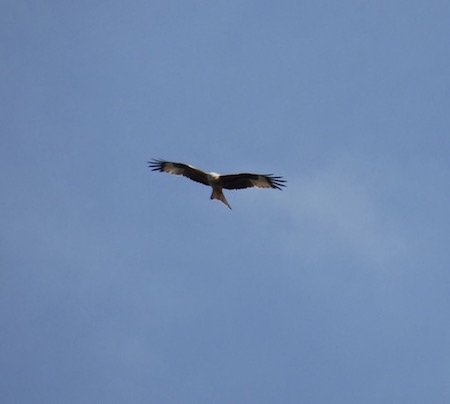
Red Kite can regularly be seen at some well known feeding stations in Wales and there have been some releases of birds in various parts of the UK. In Norfolk we also see
migrating Continental birds in early Spring and this bird seen over
Holme-next-the-Sea in mid-April, 2015 could well be one of these.
The solar eclipse
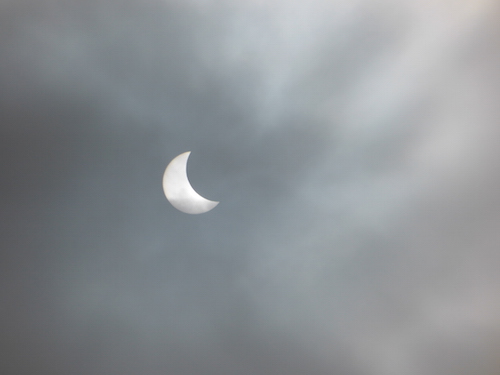
On Friday 20th March, 2015 at about 9:30 a.m. we witnessed a partial eclipse of the sun by the moon passing across its face. This photo was taken in
Holme-next-the-Sea when thin cloud cover provided good viewing as the eclipse took place.

...and this photo was taken from a projected image through a pin-hole onto a piece of white card.
OK, so they are not the best pictures around! Please do contact the webmaster at webmaster@holme-next-the-sea.co.uk if you can provide something better.
A walk on the beach
These photos were taken by Mary Burton, a resident of the village, whilst walking on the beach. They capture the beauty and tranquility of Holme-next-the-Sea and show just how lucky we are to live here!







Winter visitors at home on the beach!

Every winter the beach here is visited by Snow Buntings - sometimes a flock is made up of 60+ individuals. The photo shows part of a flock of about 30 seen on
a beautiful bright winter's day close to the golf course.
As the birds move across the beach in search of food they can appear like pieces of tissue paper blowing around in the wind!
Snow Bunting breed around the arctic from Scandinavia to Alaska, Canada and Greenland and migrate south in winter. There are a few resident breeding pairs in
Scotland.


